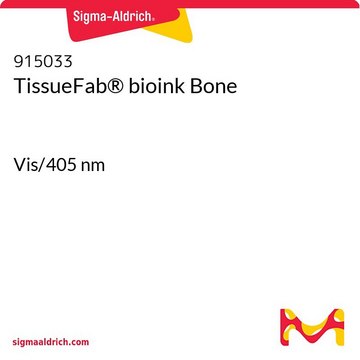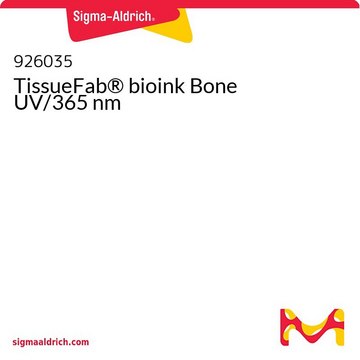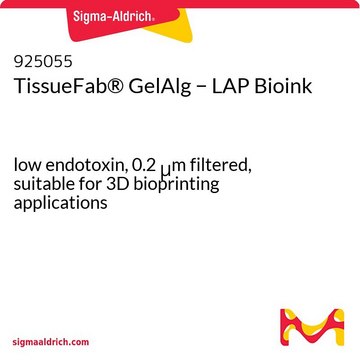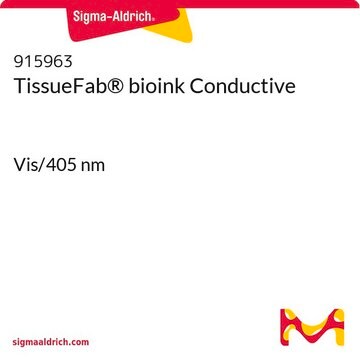926086
TissueFab® bioink Bone Vis/405 nm
Synonym(e):
3D Bioprinting, Bioink, GelMA, TissueFab
Anmeldenzur Ansicht organisationsspezifischer und vertraglich vereinbarter Preise
Alle Fotos(1)
About This Item
UNSPSC-Code:
12352201
NACRES:
NA.23
Empfohlene Produkte
Form
viscous liquid
Qualitätsniveau
Verunreinigungen
<5 CFU/g Bioburden (Total Aerobic)
<5 CFU/g Bioburden (fungal)
<50 EU/mL Endotoxin
Farbe
white
pH-Wert
6.5-7.5
Viskosität
5-50 cP(37 °C)
Anwendung(en)
3D bioprinting
Lagertemp.
2-8°C
Allgemeine Beschreibung
TissueFab® bioink Bone Vis/405 nm, low endotoxin is designed for promoting osteogenic differentiation of stem cells. It is based on Gelatin methacryloyl (GelMA) - Hydroxyapatite (HAp) hydrogel system.
HAp is a highly crystalline form of calcium phosphate. HAp has a chemical similarity with the mineralized phase of bone which accounts for their excellent biocompatibility and osteoinductive and osteoconductive properties favorable for bone regeneration. HAp-containing hydrogels has been studied in literature to demonstrate their processability with different additive manufacturing approaches. Printing of cell laden structures with HAp containing bioink formulations have shown superior osteogenic properties.
Additional Information:
The protocol for this material can be found In the Documentation Section under ″More Documents″
HAp is a highly crystalline form of calcium phosphate. HAp has a chemical similarity with the mineralized phase of bone which accounts for their excellent biocompatibility and osteoinductive and osteoconductive properties favorable for bone regeneration. HAp-containing hydrogels has been studied in literature to demonstrate their processability with different additive manufacturing approaches. Printing of cell laden structures with HAp containing bioink formulations have shown superior osteogenic properties.
Additional Information:
The protocol for this material can be found In the Documentation Section under ″More Documents″
Anwendung
TissueFab® bioink Bone Vis/405 nm, low endotoxin is a ready-to-use bioink which is formulated for high cell viability, osteoinduction and printing fidelity and is designed for extrusion-based 3D bioprinting and subsequent crosslinking with exposure to 405 nm visible light. GelMA-Bone bioinks can be used with most extrusion-based bioprinters, are biodegradable, and are compatible with human mesenchymal stem cells (hMSCs) and osteogenic cell types. TissueFab® bioink Bone Vis/405 nm, low endotoxin enables the precise fabrication of osteogenic 3D cell models and tissue constructs for research in 3D cell biology, tissue engineering, in vitro tissue models, and regenerative medicine.
Verpackung
10 mL in glass bottle
Rechtliche Hinweise
TISSUEFAB is a registered trademark of Merck KGaA, Darmstadt, Germany
Lagerklassenschlüssel
10 - Combustible liquids
WGK
WGK 3
Hier finden Sie alle aktuellen Versionen:
Analysenzertifikate (COA)
Lot/Batch Number
Leider sind derzeit keine COAs für dieses Produkt online verfügbar.
Wenn Sie Hilfe benötigen, wenden Sie sich bitte an Kundensupport
Besitzen Sie dieses Produkt bereits?
In der Dokumentenbibliothek finden Sie die Dokumentation zu den Produkten, die Sie kürzlich erworben haben.
Nano hydroxyapatite particles promote osteogenesis in a three-dimensional bio-printing construct consisting of alginate/gelatin/hASCs.
Wang X F, et al.
Royal Society of Chemistry Advances, 6, 6832?42-6832?42 (2016)
Mehdi Sadat-Shojai et al.
Materials science & engineering. C, Materials for biological applications, 49, 835-843 (2015-02-18)
The ability to encapsulate cells in three-dimensional (3D) protein-based hydrogels is potentially of benefit for tissue engineering and regenerative medicine. However, as a result of their poor mechanical strength, protein-based hydrogels have traditionally been considered for soft tissue engineering only.
Yicong Zuo et al.
ACS applied materials & interfaces, 7(19), 10386-10394 (2015-05-01)
Modular tissue engineering holds great potential in regenerating natural complex tissues by engineering three-dimensional modular scaffolds with predefined geometry and biological characters. In modular tissue-like construction, a scaffold with an appropriate mechanical rigidity for assembling fabrication and high biocompatibility for
Xi Chen et al.
International journal of nanomedicine, 11, 4707-4718 (2016-10-04)
Periodontitis is a chronic infectious disease and is the major cause of tooth loss and other oral health issues around the world. Periodontal tissue regeneration has therefore always been the ultimate goal of dentists and researchers. Existing fabrication methods mainly
Michal Bartnikowski et al.
Materials (Basel, Switzerland), 9(4) (2016-04-14)
The concept of biphasic or multi-layered compound scaffolds has been explored within numerous studies in the context of cartilage and osteochondral regeneration. To date, no system has been identified that stands out in terms of superior chondrogenesis, osteogenesis or the
Unser Team von Wissenschaftlern verfügt über Erfahrung in allen Forschungsbereichen einschließlich Life Science, Materialwissenschaften, chemischer Synthese, Chromatographie, Analytik und vielen mehr..
Setzen Sie sich mit dem technischen Dienst in Verbindung.








